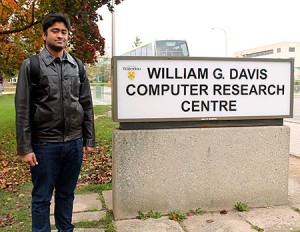BY ALEX RIESE
When looking into post-secondary institutions in Canada, international student Hazma Nadeem only researched universities for his education. He has since come to wish that he’d looked more into colleges.
“Looking at the course load right now, I’m not able to handle any other part of my life apart from my studies,” Nadeem said.
The second-year mathematics student chose to enrol at the University of Waterloo two years ago. Since then, his personal life and work life has taken second fiddle to his school life.
“In 24 hours, apart from eight hours sleep, the rest is studying,” he said.
Nadeem’s story is a typical story for a university student. With class sizes averaging between 75 and 200 people, the method university professors choose to deliver course content is via lecture. These lectures span from 50 minutes to three hours and use either a textbook or a PowerPoint presentation as supplemental tools for lecturing. Unfortunately, this method has been criticized as being biased toward one learning style, and a student’s understanding of course material can live and die by the professor’s ability to relate to the students. Additionally, the large class sizes mean that many professors are not available for individual study time with students, making it the student’s job to understand subjects that others spend lifetimes trying to discover.
Understandably, it’s common for students to attend a university program only to become frustrated with the learning styles used in university and apply to college. That was the route Rachel Kirk, a first-year television broadcasting student at Conestoga College, took, and she hasn’t looked back since.
“I just wasn’t a big fan of the learning techniques. I also decided that I didn’t want a career in psychology. As much as I loved it, I’d rather do something a little more positive, which is why I chose to attend Conestoga,” Kirk said.
Unlike university, college class sizes can be as low as 20 people per class, which means that students can get a lot more individual time with professors to ensure they understand the course material.
As well, course content is often delivered using a mixture of traditional lecture techniques and hands-on training to ensure a student gets actual experience with the subject matter in the program. Smaller class sizes also give college professors the ability to get to know their students on a more personal level, allowing them to cater their lessons to their students, a fact that Kirk appreciates.
“I feel it’s more personal. Here, the professors know my name. At university, I felt like I was more of a number,” Kirk said.
However, universities also use labs as methods of instruction to supplement lectures. These labs give students the ability to work with equipment that would be used in a typical day on the job. Natasha Amsden, a third-year kinesiology student at the University of Waterloo, expressed an appreciation for these labs, saying that they’ve really helped her understand some of her course material better.
“The labs are extremely useful. We did a biophysical evaluation lab in first year where we got to do a lot of hands-on evaluation. The lab sizes are a lot smaller so you get a lot of one-on-one interaction with the teacher’s assistant, and you get a lot of experience with the tools you’ll use later on, which is better than lecturing on the theory behind everything,” Amsden said.
Reputation of a school is also hugely important. The University of Waterloo’s reputation around the world is one of the biggest reasons why so many people choose to go there, including Nadeem.
“The University of Waterloo is ranked 23rd in the world for mathematics and third in the world for sciences, so I know the job market will be in my favour after I graduate,” Nadeem said. “I’d have a mid-career salary of about $119,000 per year. That’s why the University of Waterloo is justified for me.”

